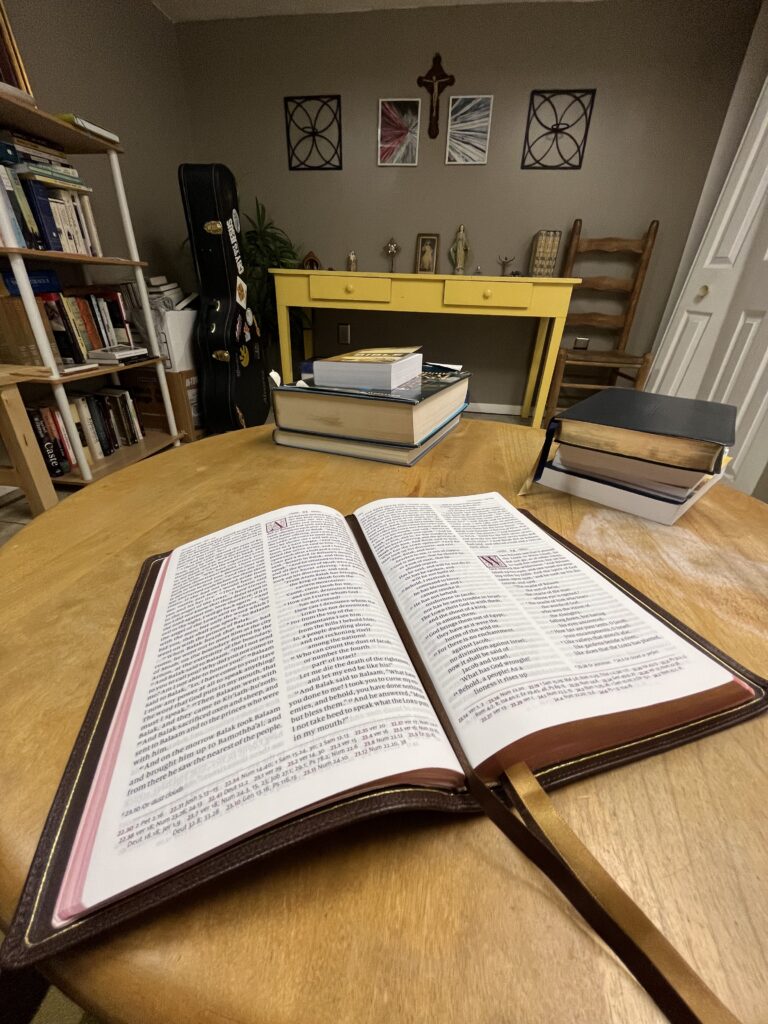
There is no comparison. The Schuyler’s Quentel Series RSV w/Apocrypha is the best all-around bible I have ever possessed and, even more importantly, used on a daily basis. It checks all the boxes that I have been pinning about for well over fifteen years, dating back to the origins of the old Catholic Bibles Blog. Ah yes, you might say that this bible isn’t technically a Catholic edition. Well, that would be true, but it contains all the books in the Catholic canon (as well as the Orthodox ones) with the inclusion of the Apocrypha/Deuterocanonical section at the back of the bible, much like the beloved NOAB w/Expanded Apocrypha. Fifteen years ago, that might have been a put-off, but I have moved on from desiring to a truly high-end bible in a specific Catholic edition. Cambridge came close with their Cornerstone, but it isn’t in the same league with this one.
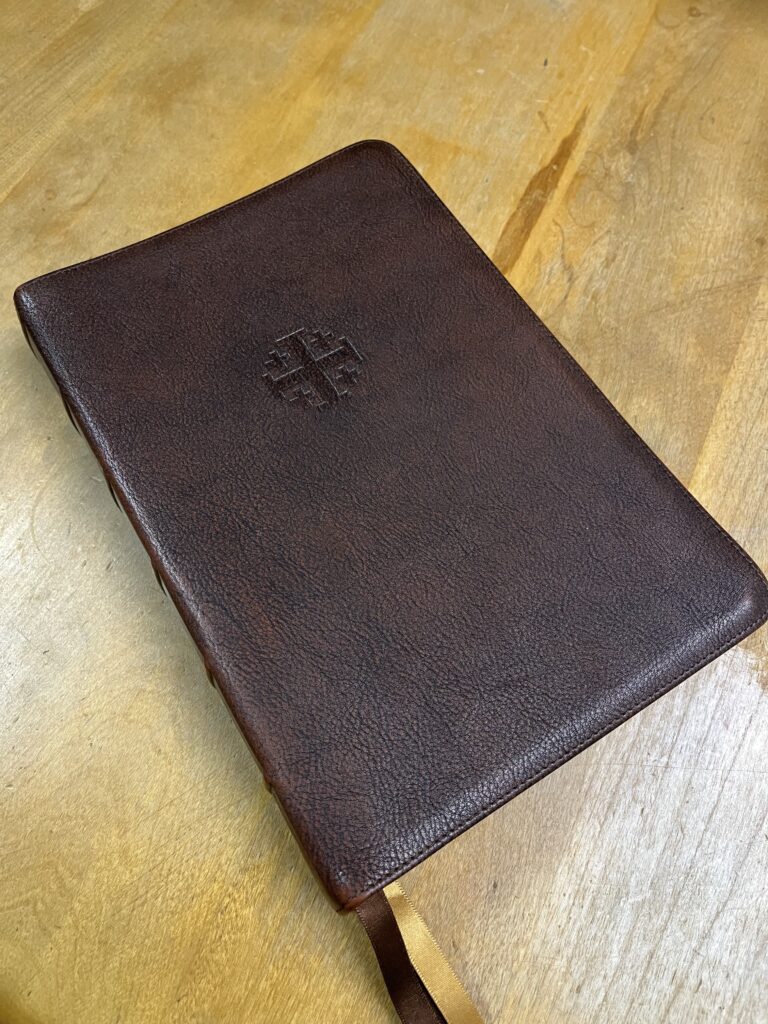
But before I go any further, here are the specs, as from the EVBible site:
Marbled Mahogany Natural Grain Calfskin Cover with calfskin leather linings (dark brown)*
10 point Milo font
Line Matching
28 GSM Paper
Page size: 6.1″ x 9.13″ x ~1.1″ (155 mm x 232 mm x ~29 mm)
3 x 1 cm Dark Brown, Gold, Dark Brown Ribbons
Art-Gilt edging (red under gold) with gilt line (gold line inside the cover)
Gold embossing on the Spine.
Raised Spine Ribs
Smyth Sewn
Ornamental drop caps
Black letter text (chapter numbers, headers and page numbers in red)
Cross references
Expanded Edition of The Apocryphal/Deuterocanonical Books
Glossary concordance
Presentation pages
Extensive Schuyler Bible Maps
*Mine is not the full-yapp edition
If you haven’t already, there are some fantastic YouTube reviews out there for you to look at concerning this bible. I would certainly recommend you to check out the reviews by Tim Wildsmith and my friend Paul Stevenson for more details. They both do a great job at giving their helpful and experienced impressions of this bible. The Schuyler RSV (both with and without the Apocrypha) is in its second printing. A few editions are already sold out, so if this bible is something you might want to purchase, you might want to consider getting it sooner rather than later.
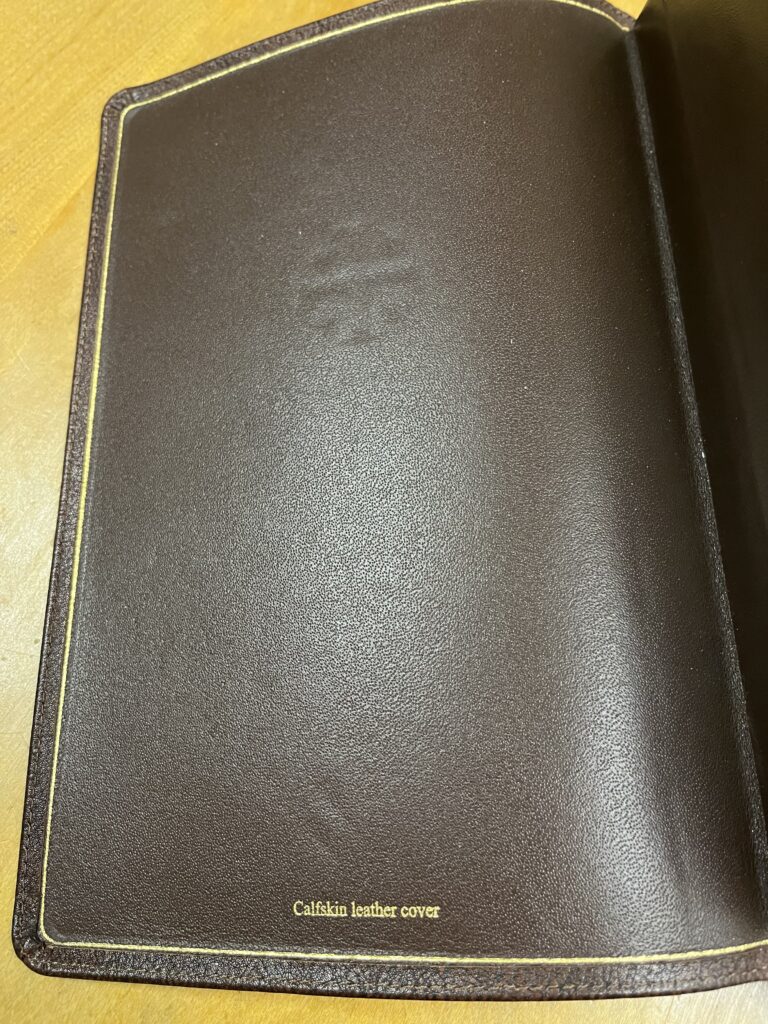
Let me say two things upfront. First, I did not receive a review copy from the publisher, rather, it was gifted to me by a good friend. So, I am under no pressure to give you a non-critical review because a publisher provided a review copy. In all my past reviews, I have tried to be as honest as possible in my assessment, no matter if a particular bible was a review copy or not. This has been the case here on Marc’s blog as well as my original one.
Secondly, I have waited until now to give a review because I wanted to “live in it” for a while. I have had my copy since the fall of 2021. Perhaps you have noticed that it has been included in various pictures of other bibles I have reviewed, as means of comparison. Since 2008, I have been searching for the “perfect” bible. That has been documented on the old blog as well as here. And in every case, there was always something that was either missing or just didn’t meet my needs. (And yes, this is totally a subjective thing, but it did make for some fun blog posts and great interactions with readers over the years.) Around 2017-2018 or so, I was feeling a bit burned out, so I ended the blog as well as stepped away from some bible teaching. I withdrew to reading more dynamic translations, which led me to spending a long season in The Message: Catholic/Ecumencial Edition and writing a book about that experience. It was a necessary retreat that I needed at the time and my soul emerged from that period being refreshed and renewed. Everything that I wrote about in the book remains true to this day, particularly the importance of daily struggling with the bible as well as finding the edition which you love to read from. I loved the MSGCE single-column format, and even though my days of reading it daily are over, it remains close at hand for the occasional comparison.
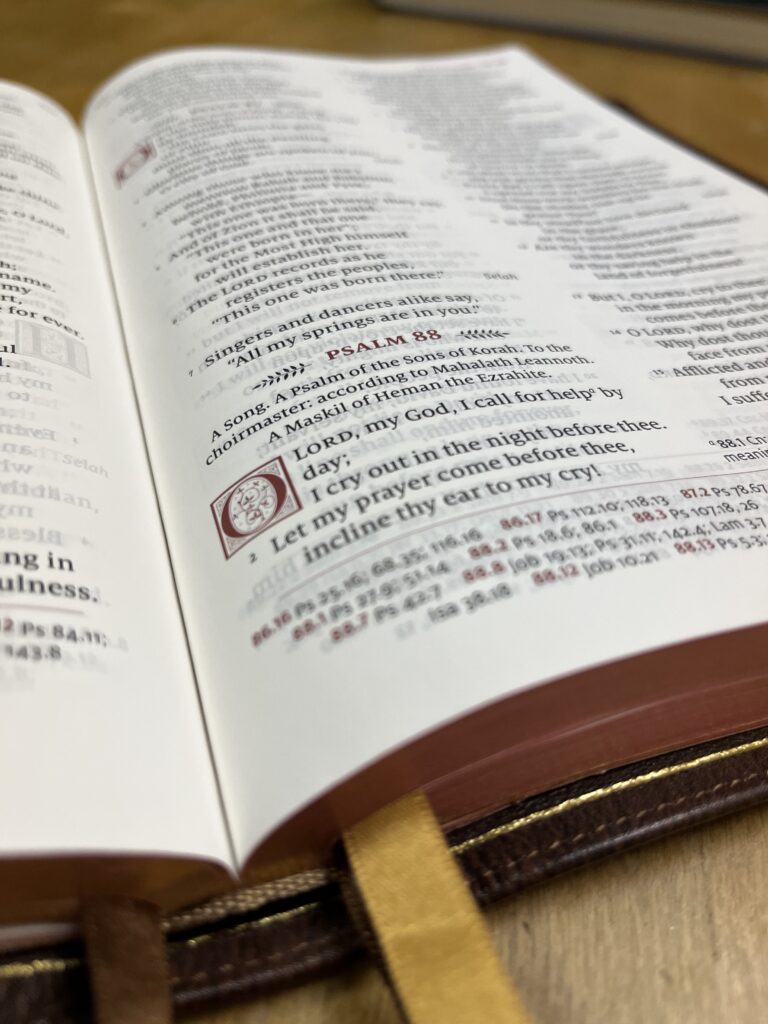
So, when it was made public that Schuyler was going to be publishing a new RSV w/Apocrypha in their Quentel Series, I was initially really excited about it. But I was a bit apprehensive of spending over $200 on a bible which I wasn’t sure was going to engage me in the same way the MSGCE had done for the prior few years. It wasn’t a single-column bible, and I wasn’t sure I would want to engage the text by writing and highlighting in such an expensive bible. Enter my friend, who gifted me with a new copy of the Marbled Mahogany edition you see in these pictures.
I wasn’t sure what to expect when my copy arrived at my front door in late September 2021. It turned out to be a sort of quasi-religious experience. Immediately upon opening the clamshell box and holding this bible in my hands, I knew that this bible was something different. The feel of the calfskin leather cover (and liner) was unlike any bible I had previously handled. It was so smooth and flexible. The simplicity of the Jerusalem Cross on the front cover was attractive, and the raised hubs on the spine were a real treat as well. The cover and the art-gilt edging along with the three high-end ribbons, made this bible a beauty to behold and handle. (I felt like the character Tim Taylor around a new set of power tools in the 90’s TV show Home Improvement.) I had held other high-end bibles, but nothing compared to this one.
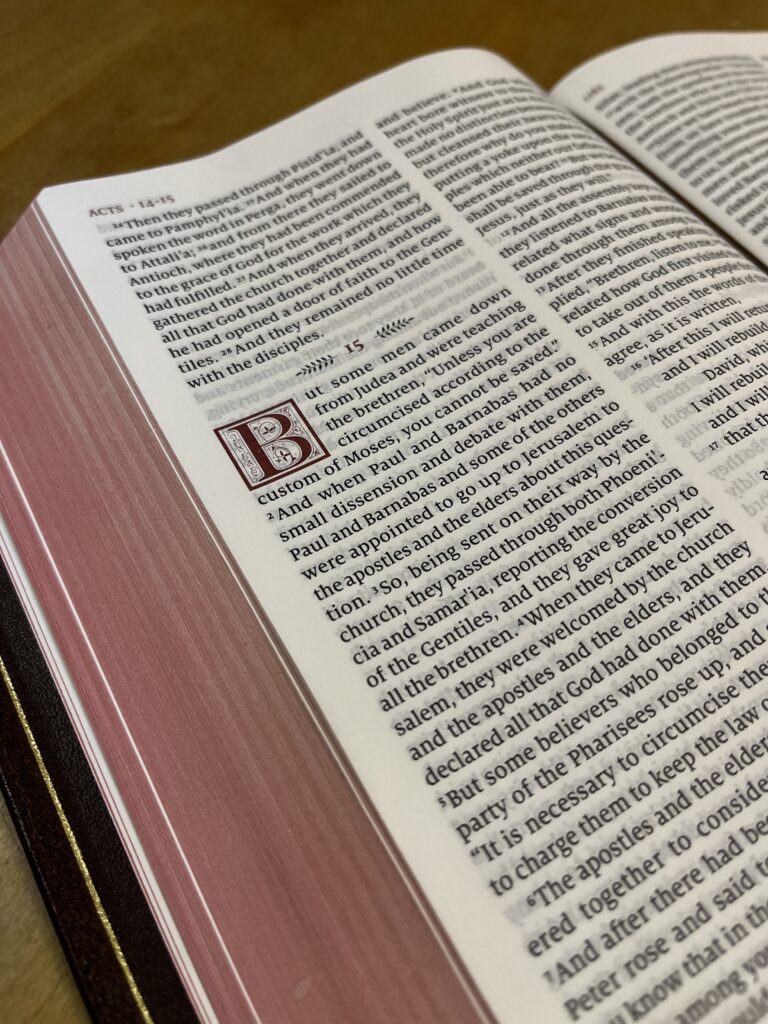
Opening the bible, I worried that I was going to miss the single-column format that I had grown to love. But my fears quickly evaporated as I began to read this bible, starting in the Psalms. The line-matched 10-point Milo font, the spacing, the glorious drop caps, the smart use of red, and the white 28 GSM paper made reading from this bible an instant joy. This is a bible that I read from early in the morning (in our prayer room) to later in the evening when our family room is more dimly lit. Because there are no paragraph headings (which I have grown to appreciate) I was initially concerned that reading through long passages (like in the historical books of the Old Testament) might become difficult. It never has been an issue due to the design of the page and the clarity of the font. This is a bible that I can grow old with. I am 45 years old, as of last month, so legacy has been something that has been on my mind in relationship to my role as a disciple of Jesus, a husband, father, and teacher. This bible edition has the potential to grow with me as I get older and (presumably) as my eyesight diminishes over time. (No issues now, but almost everyone in my family wears glasses.) There is ample room for writing in this bible as well as numerous blank pages and end pages where I have already been adding verses and comments to.
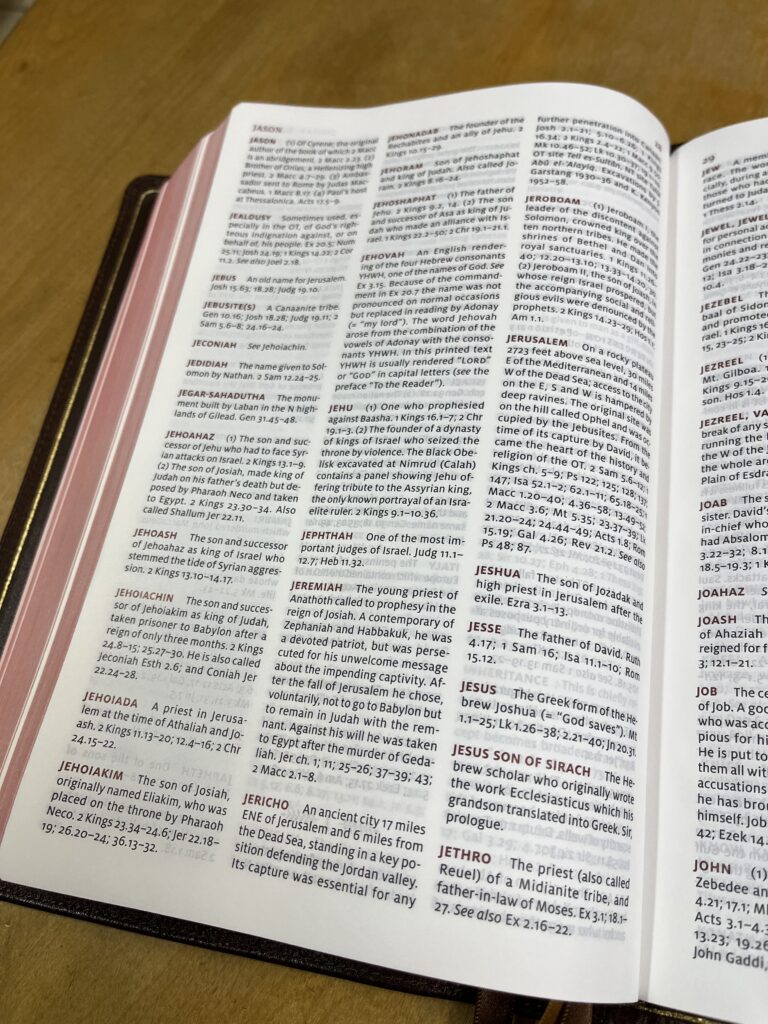
The final element I want to highlight here are the resources that this bible provides. First, the numerous page-bottom references provide ample verses to look up, but also are positioned on the page in a way that is easy to navigate while not being a distraction. Verses are listed at the bottom of the page by red verse numberings with its corresponding cross-references in black. It is super easy to use. It seems they are a corrected form of an older set belonging to a previous NRSV edition. Secondly, there is a familiar 65-page glossary/concordance in the appendix. This is the same glossary/concordance that was in the Cambridge NRSV Reference Bible w/Apocrypha that I used during my seminary classes. I have found it to be far more useful than the usual concise concordance, which have now become a bit redundant with the use of smart phones. This glossary/concordance has short definitions for major names, places, and other items, including in the Deuterocanonical books, which can be helpful in a pinch. Finally, the Schuyler maps are probably my favorite set of bible maps I have seen. I just like the overall look to them and the information that each map presents. It includes 12 maps, along with a chart of OT rulers and prophets during Israel’s United and Divided Kingdoms. (There is also an index to the maps.)
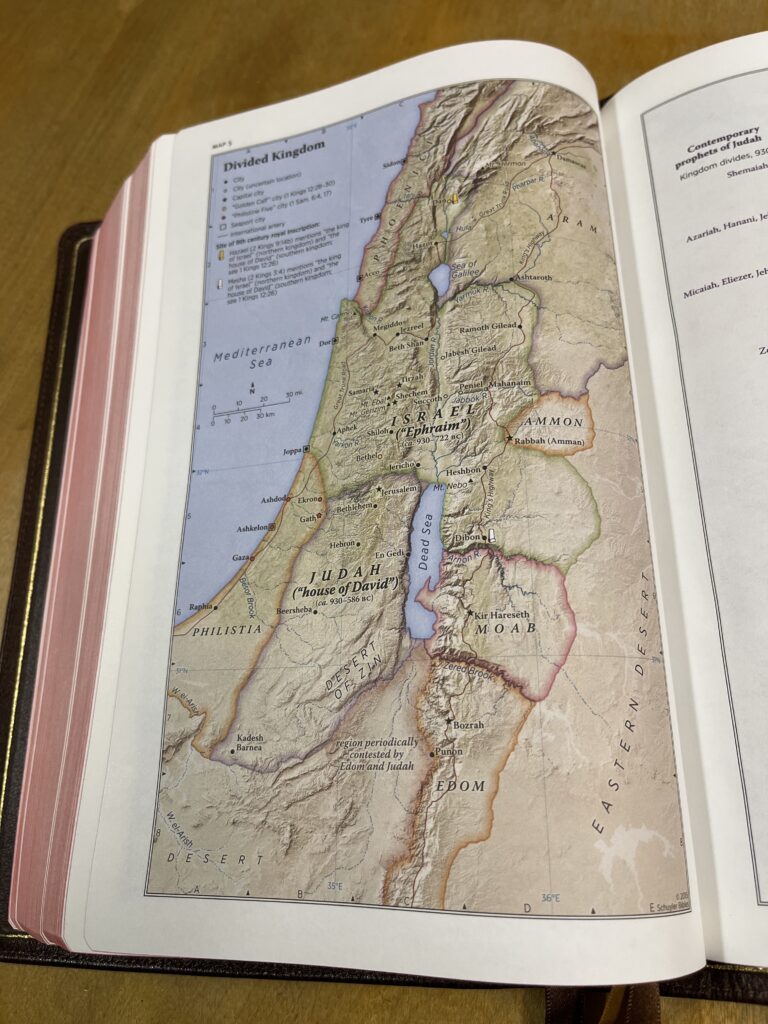
In conclusion, let me just say that the price point for this bible may be a deterrent for some people. I get that, truly. However, if you are desiring a premium bible that includes the Deuterocanonical books, in a literal translation like the RSV, this is the bible you should consider purchasing. If you want to wait until Schuyler publishes the ESV w/Apocrypha later this year or next, I totally get that as well. Having spent time last year in the ESV, as well as reading Mark Giszczak’s book, I understand the appeal of the ESV. However, this Quentel RSV is a beauty. It really is an all-purpose bible which I have used in every setting. Over the past year and a half, it has been with me when I pray and study in the morning, while at school or the parish teaching, and even in the evening as I pray before sleep. It is a premium bible that has everything I need for every occasion, while being crafted in a way which will last a lifetime. There is no comparison.
Great review of a beautiful Bible. I hope you enjoy it, brother.
Great review! I have owned this Bible since its release. (In black goatskin). While it is not a “Catholic” Bible, it does contain all the books including the Orthodox Canon and extras. It is exquisitely crafted and frankly, and absolute joy to read from and hold. As a cradle Catholic, and life long Bible addict, I find it to be the most satisfying Bible to read and pray upon that I have ever owned. It is my go to every day reading and prayer Bible.
May I ask what you mean by not Full YAP ?
I’ve been considering something like this bible or the Cambridge Diadem with APOCRYPHA since the Cornerstone came out as it seems lacking for a premium bible even though it is a true Catholic Bible. As I have been after a true bible I can keep for years to come as I approach my confirmation and first communion on the Easter Vigil.
Matthew,
Below is an article that explains Bible Yapp. Mine is the standard size, but they have edition which have more leather on the cover that overlaps the pages.
https://www.bibles-direct.co.uk/blog/?p=93
And I had great hopes for the Cornerstone, but for me, I like having the references, the glossary, and color maps that the Schuyler provides.
Thank you for the link had never heard of the word before appreciate you replying to me.
Yeah when I heard about the Cornerstone I thought it would be a good idea a proper Catholic Bible from a Quality Bible Maker but seems they did it half assed. I am half debating getting the Faux Leather Cornerstone and getting it rebound in a nice quality Leather but if I’m going do that I might as well just get the Cambridge Diadem Leather Version with the references and colour maps.
I am looking forward to the upcoming CTS ESV CE I know it will only be Hardback but with the updated Grail Psalms used in Lectionary in my country will be nice to have and probably have an imperator from English and Welsh Bishops.
I pre-ordered this immediately because I knew I would kick myself later if I passed! I remember the preorder sold out quick and a reprint was offered later. I got 1 regular yapp for myself and 2 full yapp editions for my parents who are not Catholic.
I love the language and style of the RSV. I also love that it is a translation that I can share with friends and family who are not Catholic, and I have given away many copies of the NOAB RSV.
It’s a blessing that this edition (1971 NT and Deuteros) and the 1966 CE continue to be popular and in print alongside their modernized editions which are subject to future revisions. I take the Scepter Daily Bible to Mass with me and there is very little difference from the lectionary except that I prefer the language of the RSV. I like to pray and meditate with the Scripture before or after Mass, and at adoration, so I appreciate the formal language in the prayers in the RSV. Most of the small classes and meetings I attend I bring the Scepter edition of the RSV-CE in a small Bible cover with a small edition of the catechism. I usually don’t take the Schuyler out of my room, it is a treasured possession. Maybe I could get it covered in my insurance… JK 🙂
As much as I like old English and the history of the english language, I prefer my Bibles to use modern pronouns. Otherwise, this sounds like such a great Bible.
I can understand that desire, even if I don’t share it. There can sometimes be too important of theological points based on whether a “you” is singular or plural in a particular Bible passage, so I kinda get annoyed when I get to a page in John or something in a modern translation and half the page-bottom notes are “Gk. you is plural” and “Gk. you is singular” to the point I’m like “If it’s really this important, just put the thees and thous back in.”
Sure, but the RSV doesn’t maintain the singular/plural distinction. It only uses thee/thou in reference to God. The result, to me, makes the RSV sound sporadically archaic while providing no information about plural vs. singular. That’s why I prefer the RSV-2CE or the other RSV derivatives, but if you want a singular/plural distinction, you’d need to use some other translation, like the ASV.
I agree. I wasn’t referring to the RSV as a “good” example of thee/thou usage; I was just speaking in general, like comparing the ASV versus, say, the NRSV in that department, and generally commenting on the point of old versus modern pronouns in translations that was mentioned. In fact, the sporadic approach to the thees and thous, in the original RSV and translations from the same period, truly is the silliest and least helpful option imo, as it’s just aesthetic at that point. Either go all the way or don’t bother. That’s why I, too, prefer the approach of the RSV-2CE vs the 1CE, because at least it’s consistent. Alas, I feel I always need a KJV or ASV nearby, if only for their clear pronoun usage.
Thee and thou are not “old English” it s Elizabethan English, also known as Early Modern English. Old English is actually a completely different language from English that you could not read at all unless it is translated into English. Beowulf (approximately 9th century) is in Old English.
The KJV isn’t Old English, but it is old English.
Let me clarify. I have several Anglo-Saxon texts hanging around the house as well as texts from Middle English and early modern English (mainly Shakespeare). As fascinated as I am by the development the English tongue, when it comes to the language of prayer, I prefer to keep it fully within modern usage. If I had my way, I would remove the “thy”s along with the “art” from the Our Father during the liturgy. I agree with Philip and Anonymous and keep things consistent. I could read the Douay Rheims but not the original RSV.
It is a sociological principle that the language used in a religious context tends to become fixed in a certain period and then ceases to evolve any further. Therefore the language used in a religious context is always more antiquated than the language used in any other context. It happens with every religion, country, and language in the world.
Catholics still use Latin to pray
Jews still use (Biblical not modern) Hebrew to pray
Muslims use 8th-century Arabic to pray
Hindus use Sanskrit
Both Catholics and Protestants still use Elizabethan English
The examples could be multiplied by 1,000. I could speak on this subject literally for hours.
The specific example of the Our Father is interesting because although Catholics and Protestants both use the same translation namely
Our Father Who Art In Heaven
Hallowed by thy name
Thy Will be done on Earth as it is in heaven
Give us this day our daily bread and forgive us our trespasses as we forgive those who trespass against us
And lead us not into temptation but deliver us from evil
This text comes from NO translation of the Bible, it isn’t from the KJV, and it isn’t from the Douay Rheims, do you know where it comes from? It comes from the 1662 edition of the Book of Common Prayer, I kid you not. How did this one obscure translation become THE universal one, used always, everywhere, and by everyone? I honestly have no idea.
Anyway, an important addendum to the “religious language is always antiquated” is that “attempting to reform or update the language used is almost always destructive”
The Anglican Church updated the Book of Common Prayer, and now the churches are empty. The Catholic Church stopped using Latin in the Mass, and Mass attendance plummeted. Liberal Jews stopped using Hebrew, now they are almost all fully secularized. This kind of thing always happens. Religious language being antiquated is a good thing, it has a way of making religion more sacred, that is why this is a universal practice.
The Book of Common Prayer is one of the most influential texts in the history of English. It’s not obscure by any means.
Indeed. Even the “new translation” of the Qur’an in the “Study Qur’an” of 2015 still uses “thee” and “thou” throughout.
It really is a beautiful Bible… Thanks for the full review!
Any possibility of reviewing the new KJV w/ Apocrypha editions that Thomas Nelson just published?
Fr JT,
I have a black leather soft edition on order. Will post when I receive it and then do a full review afterwards.
I must say, it looks really good.
Fr. JT,
I did receive my edition but haven’t had time to really get into it yet. Planning to post some photos at some point. Until then, here is YouTube review that just came out on this:
https://www.youtube.com/watch?v=5t3Ipba9_c4
Thanks for the comment, and for the now-posted review! I’m just edified that there’s enough interest in the Deuteros among KJV readers (or interest in the KJV among full-Canon readers) to warrant the publication.
I had struggled with ordering or not ordering when it came out and I thought that issue had been settled and I had been at peace with the decision not to get one.
Then this review pops up! Get behind me, Satan! Lol
Ha! Sorry about that Tim. 🙂
Is a ESV w/ Apocrypha actually in the works, or was that comment in the last paragraph an assumption that it’ll happen? I bought the RSV as my edc for use with Bible in a Year and have ZERO regrets. Because I also own a AI ESV hardcover, I don’t feel the need to purchase a premium version (especially since a CSV study bible is most likely in the works), but the RSVw/A is so good that I don’t think I’d be able to pass up on that offering, should it become a reality. Can’t find any preproduction info like was available for the RSV prior to preorder.
JD,
Schuyler has announced that it will happen at the end of this year or early next year.
I only see full yapp versions on the website. Anyone know if they will reprint the standard version again?
Tim,
I was trying to find an announcement which I read about what they were planning to do in the future with their Quentel RSV, but I can’t seem to find it. The ones that are listed now are a second printing, so it is a bit uncertain whether they will do another. And with the ESV w/apocrypha coming out that may have an influence on future RSV w/apocrypha editions too. So, perhaps someone else will be able to respond. If you email them, they are usually really good at getting back to you after a few days.
Thanks, as always, Timothy
I had been considering investing in the RSV Quentel for the better part of the last year, and this review convinced me to go for it. Yeah, that was a good call. I bought the blue full-yap, and it’s seriously a work of art. More importantly, I can read and pray with a Bible that is a trustworthy translation and isn’t going to fall apart within the next couple years. Thanks for reviewing it!
Fr. JT,
I am really happy to hear that you purchased a copy. Everything you wrote about it is absolutely correct. Among all its awesomeness, it has one quality that almost every Catholic bible edition lacks: It is both eminently useful in almost every situation (pastorally, for study, for devotional reading) while also being a beautiful bible to read from and grow with. It is a bible for the long haul.
I like the Schuyler bibles. I went with the Thomas Nelson/ Zondervan Premier Series NRSVue. Because they are half the price and still get a beautiful premium bible.
Awesome, it’s a beautiful-looking Bible, for sure. How do you like it?
I’ve been trying to find this RSV edition with the Apocrypha but it looks as if it’s sold out now and possibly discontinued; sadly.
You know, I’ve gone back and forth with translations over the past year and a half – RSV2CE, ESV, NRSV, and NABRE. But, despite a handful of places where the RSV1971 drives me nuts (like relegating the supposed Western Non-interpolations in Luke 24 to the footnotes, or translation choices like “powers of death” rather than “gates of Hades”), the Schuyler RSV can’t be beat for sheer readability. As much as I prefer the 2CE, I can’t find a printing that is as easy and pleasant to read as the Schuyler, and I can always write in where the 2CE or NRSV might have a different rendering.
FRJT,
I came back to this comment of yours as I am trying to decide whether or not to get the Schuyler ESV w/Apocrypha. I have been using the Augustine Institute ESV for well over a year now. I think I prefer it to the RSV. But the issue is form factor and how it reads. The Schuyler is just unmatched. The ten point font is amazing and the whole experience reading from it is superior to all my other bibles. And the extras (not only the quality leather but the vastly superior maps) are second to none. So, I’m trying to decide whether or not to get the ESV w/apocrypha or stick with the RSV. My students use the Ignatius RSV-2CE, so while the RSV might be the better option, the ESV is hardly that much different. Thanks for your comment. It has helped me to think through this a bit.
The RSV and ESV Quentels are both amazing, as is the Zondervan NRSVue with Apocrypha, and the premium edition of the Great Adventure Catholic Bible (published since my August 2024 comment). The goatskin GACB has actually become my go-to, and I gave away it RSV Quentel. I’ve been looking for years for “the one”, and that one finally filled the slot – not to complicate your decision-making… Sorry!
As far as translations go, there are certain things I like in the RSV over the ESV, and vice versa. The ESV has phenomenal OT translation notes.